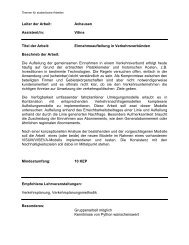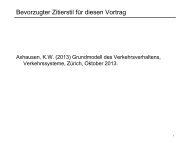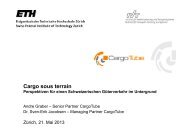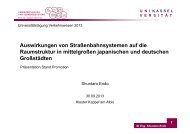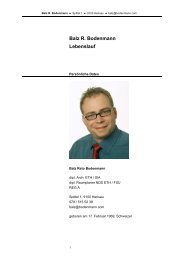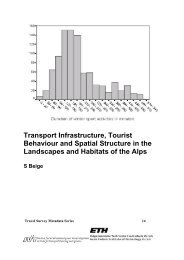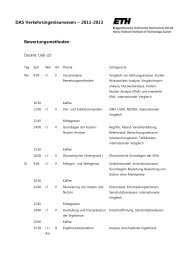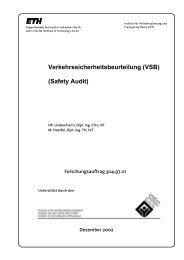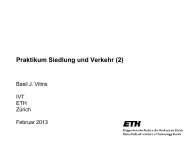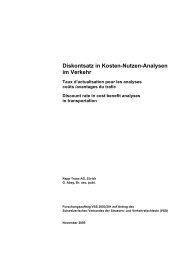A Tour-Based Model of Travel Mode Choice - Civil Engineering ...
A Tour-Based Model of Travel Mode Choice - Civil Engineering ...
A Tour-Based Model of Travel Mode Choice - Civil Engineering ...
Create successful ePaper yourself
Turn your PDF publications into a flip-book with our unique Google optimized e-Paper software.
10 th International Conference on <strong>Travel</strong> Behaviour Research<br />
August 10-15, 2003<br />
With respect to car allocation, treatment varies among models. For example, the Danish<br />
model directly incorporates household car availability in the tree structure; the Stockholm<br />
model considers a level for the car allocation process that defines the possible mode choice<br />
options; and the San Francisco model considers vehicle availability at higher levels, above<br />
tour and trip generation. However, it is not clear whether these models allow for more complex<br />
car allocation behavior, such as the use <strong>of</strong> a same car by different members <strong>of</strong> the household<br />
within the day.<br />
Finally, another relevant group <strong>of</strong> complex mode-choice models are the so-called rule-based<br />
models, which try to incorporate modal choices within the scheduling process itself. Some<br />
examples are the ALBATROSS model by Arentze and Timmermans (2000), and the work by<br />
Kitamura, et al., (2000). In the case <strong>of</strong> ALBATROSS, mode choice is incorporated in two locations<br />
within the six-step scheduling process: in the first step, which defines the mode for<br />
primary work activities; and in the fifth step, at the level <strong>of</strong> each trip chain with “other” nonprimary-work<br />
purposes. Kitamura, et al. (2000), on the other hand, use a process <strong>of</strong> “sequential<br />
history and time-<strong>of</strong>-day dependent structure”, where mode choice occurs after the activity<br />
type, duration, and destination choices. <strong>Mode</strong> choice is modelled in this case using transition<br />
probabilities that depend on the previous trips, using the same concept <strong>of</strong> “primary mode” as<br />
discussed before.<br />
4. Conceptual <strong><strong>Mode</strong>l</strong><br />
4.1 Introduction<br />
In this section the conceptual model <strong>of</strong> tour-based mode choice is developed. This model is<br />
elaborated in several steps. First, the “base” model dealing with how an individual chooses<br />
the travel mode(s) to be used on a single home-based trip chain in the absence <strong>of</strong> householdlevel<br />
constraints (e.g., car availability) or interactions (e.g., ride-sharing) is presented. Second,<br />
a household-level mechanism for resolving competing demands for the household’s vehicle<br />
fleet is developed. Finally, procedures for dealing with ride-sharing among household<br />
members, either as part <strong>of</strong> a “serve-passenger” task or as part <strong>of</strong> a joint travel activity, are<br />
sketched.<br />
4.2 Individual Trip-Maker <strong>Tour</strong> <strong>Mode</strong> <strong>Choice</strong><br />
The problem at hand is to determine the travel modes used for each trip in a known set <strong>of</strong><br />
home-based tours for each individual within a household for a twenty-four-hour weekday.<br />
For the moment it is assumed that if a licensed driver wishes to use a household car on a<br />
given trip chain he/she may do so. It is also initially assumed that “auto passenger” or “ridesharing”<br />
modes <strong>of</strong> travel are not available.<br />
Sub-chains, involving a connected set <strong>of</strong> trips that begin and end at the same non-home anchor<br />
point, may exist within the model. Although virtually any activity location might be an<br />
5



